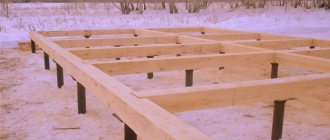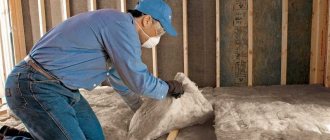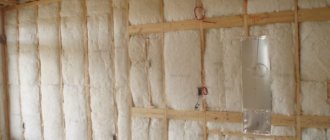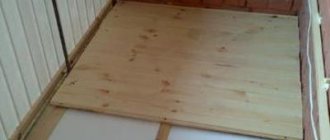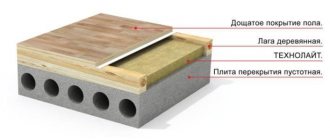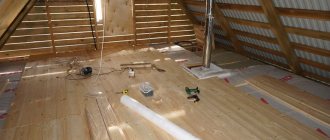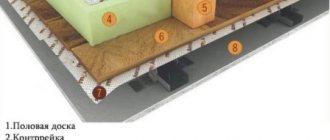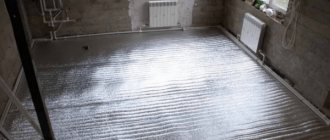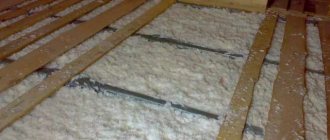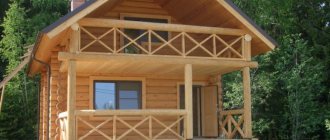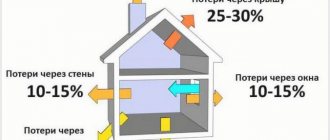Advantages of bottom insulation
From the point of view of labor costs, it is more profitable to insulate the floor from above. In this case, the insulating layer is mounted between the frame (joists) and the top finishing layer.
But in some situations, bottom insulation is preferable.
This method of thermal insulation is most often used in private houses with an uninsulated basement, garage, and in frame buildings on pile and pile-screw foundations.
Bottom insulation has a number of advantages:
- the insulation layer is not subject to loads from furniture standing on the floor and people moving around the house, so you can use thermal insulation material of any hardness;
- the height of the room does not decrease;
- Not only the top flooring, but also the entire floor frame is protected from freezing, which reduces the likelihood of freezing and water getting on the wood - this increases the service life of wooden structures and ensures their reliability.
It is more expedient to insulate a house on stilts from below Source valet.ru
Thermal insulation materials
The choice of insulation for a wooden house is based on two criteria: non-flammability and the ability to resist the formation of mold fungi and other microorganisms. But when choosing a material for lower insulation, the specific situation and the intended installation method are taken into account.
Before purchasing materials, it is better to consult with a contractor than to insulate the floor in a private house from below. Most often used:
- mineral wool;
- Styrofoam;
- penoplex;
- penofol;
- expanded clay
Mineral wool is considered one of the best insulation materials, so many people prefer it. A plus is good sound insulation performance. Cotton wool is not subject to biological destruction and does not burn.
Cons: low mechanical strength and deterioration of thermal insulation properties when exposed to water or steam. Therefore, when using, special attention should be paid to vapor and waterproofing. Cotton wool can be presented in flexible rolls or dense slabs.
Mineral wool in slabs is often used for insulation on the basement side Source silastroy.com
See also: Catalog of companies that specialize in home insulation.
Polystyrene foam is another popular insulation material. Combines the good qualities of mineral wool and mechanical strength. But in case of possible fire it releases toxic substances. Thanks to its structure, it retains heat well and ensures minimal heat loss. Long service life eliminates the need for replacement, but the ability to absorb moisture may negatively affect some characteristics.
Penoplex . A recently appeared material is based on polystyrene, into which gas is introduced. The mass is foamed and squeezed into molding containers. The gas evaporates and the output is a sheet of insulation with many pores. This is a material with unique thermal insulation characteristics, very light, and easy to install. Durability and immunity to biological organisms ensure a long service life. The material is not flammable, does not emit harmful substances and does not absorb water.
Penofol is a material for the production of which foamed polyethylene is used. An aluminum film is applied to its top layer, which reflects heat, giving the room the characteristics of a thermos. The structure of penofol does not contain pores, which prevents it from allowing air to pass through.
Penofol perfectly reflects heat Source ultra-term.ru
Expanded clay is a bulk material in the form of porous balls, which is formed during the firing of clay or shale. This is a completely environmentally friendly material that has high heat savings, good fire resistance and resistance to freezing. But over time, expanded clay cakes under the influence of gravity and begins to lose quality, so this material must be changed periodically.
To decide how to insulate the floor in a wooden house from below, you need to choose the insulation that will perform the function of a heat insulator better than others in a particular situation.
Insulation methods
Thermal insulation of floors in a private house is required in the following situations:
- for floors located above cold floors and cellars;
- for laying in ceilings between floors;
- for processing floors under the attic, if there is one.
When the floor in a wooden house is insulated from below, the following problems are solved:
- extra costs for operating the heating system;
- violations in the temperature and humidity conditions at home;
- rotting of materials in floor structures;
- formation of mold, mildew, etc.
When a house is being built from scratch, it is recommended to take care of a high-quality thermal insulation layer. In this case, everything is much simpler, because the installation is carried out layer by layer, and the owner can think in advance about the layout of the floors in the house on each floor. Naturally, based on personal preferences, the owner can create ceilings and floors that he will be proud to publish in photos on social networks and show off to his guests.
Principles of installation work
Regardless of the choice of type of thermal insulation, it is necessary to follow the sequence of work performed for proper insulation. If we consider the structure from bottom to top, it will look like this:
- waterproofing layer;
- thermal insulation layer;
- vapor barrier layer;
- design for floor installation;
- floor.
Compliance with this order of work guarantees the maintenance of normal temperature conditions in the room and protection of the structure from freezing and rotting.
The easiest way to insulate the bottom is through joists. They are beams measuring 5x10 cm or more, on which the floor is subsequently laid.
Scheme of floor insulation using joists Source nehomesdeaf.org
Technology and features of floor insulation from below in a wooden house
For each type of insulation, there are some specific features of use.
Mineral wool
The sizes of rolls and slabs are usually multiples of 60 cm, which makes this distance the optimal step between the logs. Mineral wool is cut to size with a cutter and placed in the space between the joists. For a tight fit, the size should be 1–2 cm larger than the distance between the joists. Cotton wool should not be pressed down forcefully as this may affect its characteristics.
The best option would be to lay two layers of insulation. The second layer is laid so that the joint of the lower layer falls on the center of the upper piece. This method of installation will prevent cold air from entering the room.
How to insulate a concrete floor in a house
If you are wondering how to insulate the floor in an old wooden house where the floor is made of concrete, check out the step-by-step instructions:
- Create a multi-layer base that will provide reliable protection for the insulation. In no case do not abandon the waterproofing layer, since concrete allows moisture to pass through well, and it will gradually transfer to the layer formed for thermal insulation.
- Make a sheathing consisting of metal or wooden slats. Lay the resulting frame (this step is required when implementing the classic version of floor insulation from below using mineral wool).
- Having cut the insulation into strips of the required size, install it into the cells by surprise.
- Next, proceed to organizing work aimed at protecting the heat-insulating layer from fumes.
- Place a counter-lattice and plywood or other material of the same type on top of the vapor barrier film (without the use of lathing, the work process goes faster, but later difficulties arise associated with installing the sheathing).
Sawdust floor insulation technology
Consider an economical option using sawdust. The work is carried out before the flooring is laid.
Before insulation, treat the sawdust with a special antiseptic and dry thoroughly.
By doing this you can protect the material from mold and rodents.
When the insulation is ready for use, use a shovel to evenly distribute slaked lime into it. To determine the required amount of this material, focus on the amount of sawdust (you will need 1/10 of the insulation taken).
At the next stage, be sure to add gypsum, it will add strength to the thermal insulation material. Maintain a ratio of 17:2:1 (sawdust: lime: gypsum). After adding water, prepare a moderately cool solution.
Fill the cells gradually, placing the solution in small portions.
Insulation of floors with mineral wool
Make sure the boards to be treated are dry. If not, dry them thoroughly first.
Create a layer of waterproofing, then lay mineral wool, having previously cut it into pieces of the required size. Use thin stainless steel wire and staples as fasteners. The wire can be replaced with plastic mesh. The thermal insulation layer will protect against steam using a special membrane.
Floor insulation with penofol
Install the insulation so that its reflective side is directed downwards, that is, towards the warm space.
Attach the insulation to the joists, maintaining a small gap between it and the rough surface. Secure the material with slats, filling them in a perpendicular direction, or with construction staples.
Insulation of basement floors
If the house has a basement, the process of increasing the thermal insulation properties of coatings should begin with this room, since heat loss is the highest in it.
If you want to know how to insulate a floor without opening it, consider this procedure:
- prepare small-thick wooden slats and securely attach a film that provides a vapor barrier to the ceiling lining. Make sure that the overlap is 10 cm;
- When filling wooden blocks, keep gaps between them that correspond to the size of the slabs with which you plan to insulate;
- place insulation boards into the cells, secure them securely with slats or wire mesh;
- Attach boards on top of the insulating layer.
The process of insulating the floor is quite simple and can be done independently. The choice of material remains with the consumer. Consider all the options presented and choose the one that suits your case best.
Penoplex and foam plastic
If foam plastic is used when insulating a wooden floor from below in a private house, you must take into account several rules for working with it:
- Foam absorbs water, so waterproofing is required. Many experts do not take this property into account during installation, which leads to a decrease in thermal insulation characteristics.
- It is recommended to cut the sheets not exactly to the size of the gap between the joists, but 1–2 cm smaller. This will allow you to fill the gaps between the sheet and the joist with polyurethane foam, which will increase the thermal insulation properties. The joints between the sheets also need to be foamed.
Sheets can be fastened using slats, spacer wedges or special adhesives.
Floor insulation with foam plastic in a wooden house Source sk-amigo.ru
The principle of working with penoplex is no different. But due to the smaller thickness of the material, it can be laid with overlapping sheet joints to avoid the formation of cold islands (similar to mineral wool).
But this method significantly increases material consumption, which means additional financial costs.
Penofol
Due to its property of not allowing moisture to pass through, penofol does not require additional installation of vapor and waterproofing. But to prevent the water vapor that forms in the room from settling on the insulation layer, an air gap is needed between it and the flooring for air circulation.
Laying is done with the foil side up only. This will allow heat to be reflected, which will increase the temperature in the house. Penofol can be used as waterproofing when laying mineral wool or polystyrene foam. This can increase thermal insulation several times, but this method is quite expensive.
Penofol joints are sealed with adhesive tape Source build.4-u.info
The material is sold in rolls and can be easily cut into pieces of the desired size. Fastening is carried out with a construction stapler on staples or with thin slats that are nailed. To improve the result, it is recommended to lay penofol in several layers.
Floor insulation
Below are step-by-step instructions for insulating a wooden floor using Tepofol. This is a unique material made of non-crosslinked polyethylene foam. It has noise, moisture and heat insulation properties.
Scheme of thermal insulation of the floor of a wooden house
Step 1 . Unfold the roll of insulation and carefully cut it into equal parts, the length of which should correspond to the length of the house. The material is quite easy to cut, so you can handle it with a regular stationery knife.
Cut the insulation into pieces
Step 2 . Treat the wood used to make various pies and logs using special impregnations. This will increase the fire resistance, moisture resistance and, as a result, the service life of the tree.
Treat the wood surface
Step 3 . Lay a layer of waterproofing around the entire perimeter of the concrete foundation of the building.
Lay a layer of waterproofing
Step 4 . Install the wooden strapping beam on the foundation on top of the previously laid layer of waterproofing material. The beam must be securely fixed.
Install the strapping beam
Step 5 . After fixing the beam, install special fasteners on it for subsequent fixation of wooden logs. The elements must be installed at a distance of 60 cm from each other.
Install joist fastenings
Step 6 . Install the logs onto the ready-made fasteners, securing them using ordinary self-tapping screws. The levels of the strapping beam and joists must match.
Log installation process
Lay the joists flush with the strapping beam
Step 7 . Secure special support boards between the joists, using metal corners as fixing elements. Boards are needed for installing insulation.
Install metal corners
Install the support boards
Step 8 . Lay the previously prepared pieces of insulation across the wooden joists. The material should rest on the sides of the cross boards and on the strapping beam. Lay the material over the entire area of the house, tightly joining the pieces of insulation together.
Start laying insulation
The process of laying insulation
Step 9 . Use special dowels to fix the insulation, attaching the material to the surface of the log.
Use special dowels with a plastic insert
Step 10 . Now secure the laid layer of insulation around the perimeter of the strapping beam. For fixation, use self-tapping screws and a special block no more than 5 cm thick.
Secure the insulation with a wooden block
The beam is attached along the entire perimeter of the floor
Step 11 . Treat the joints of the insulation sheets using a hair dryer. This will eliminate any existing cracks through which cold air could enter the house.
Treat the joints with a hair dryer
Step 12 . Perform the lathing on top of the thermal insulation layer. To do this, fix small bars along the logs, fixing them every 50-55 cm. To do this, it is advisable to use long screws and screw them in in pairs.
Install the sheathing
Self-tapping screws should be screwed in at an angle of 45 degrees
Scheme for screwing in self-tapping screws
Step 13 . Secure the floor boards by nailing them to the surface of the previously made sheathing bars. The next stage of work is finishing.
Install floor boards
Step 14 . The floor insulation work can now be considered complete. Enjoy the results.
The result of floor insulation work
Expert opinion
Afanasyev E.V.
Chief editor of the pol-exp.com project Engineer.
When choosing insulation for a country wooden house, it is necessary to rely not only on the technical indicators of a particular material. The conditions under which the selected insulation will be used should also be taken into account. This is the only way to choose the most optimal option. But if your choice is two options that are almost the same in price and quality, you should give preference to a more well-known brand.
Insulation of a wooden floor in a private house
On a note! If the insulation was made by a well-known manufacturer, then the chances that it will last for many years without any complaints will be much greater.
